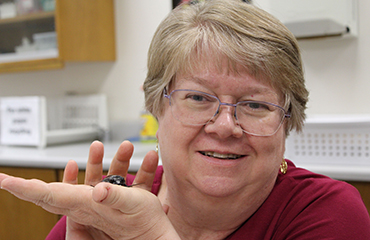
There’s one biology lab each semester at Lander University where students either fall in love or try not to scream.
The object of their affection or hesitation? Madagascar hissing cockroaches.
Elisabeth Zimmerman, senior instructor of biology, has been using the cockroaches at Lander for around 10 years in her “What’s Alive” lab, which educates students about the characteristics of living things.
One defining characteristic, she said, is metabolism, which encompasses the set of chemical reactions found in living organisms.
“Cellular respiration is one of those chemical reactions and involves breaking down glucose to produce energy,” Zimmerman said. “When glucose is broken down, carbon dioxide is produced.”
During a lab experiment, the Madagascar cockroaches are put into a sealed chamber. A probe is then used to measure the amount of carbon dioxide and oxygen inside the chamber.
“It is one thing to talk about cellular respiration, but it is more fun and engaging for students to measure cellular respiration in living cockroaches,” Zimmerman said.
“In introductory biology courses, it is sometimes easier to use models to teach concepts but I like to use living specimens when possible to remind students that biology is the study of living organisms.”
Zimmerman said she has some students that “absolutely fall in love” with the cockroaches while others back away and want nothing to do with them. At a lab table of four students, she said, there is usually at least one of each type, but she is willing to do all the handling for them if needed.
Zimmerman said they could use crickets for the experiment, but they would need a lot of them, and crickets are insects that could easily escape.
The Madagascar cockroaches hiss primarily as a defense mechanism, but the hissing also is associated with their roach hierarchy. Males hiss more than females do, Zimmerman said.
They hiss by contracting their bodies and blowing air out of their spiracles, which are small holes located on the sides of their abdomen.
This method of making noise is different from other insects. The periodical cicadas that have emerged in parts of South Carolina over recent weeks make noise by vibrating an organ on their bodies called a tymbal. Crickets make noise by rubbing their legs and/or wings together.
For more information about studying biology at Lander, go online to www.lander.edu/biology.